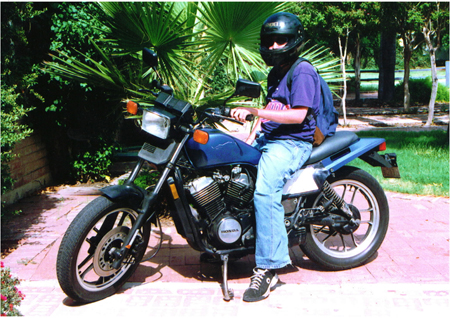 Jesse’s
Intent
Jesse’s
Intent
The story of Jesse Geslinger as written by his father, Paul.
|
Born on June 18, 1981, Jesse Gelsinger was a real character in a lot of ways. Not having picked out a name for him prior to his birth, the name Jesse came to us three days later. When considering a middle name, we pondered James, after his grandfather, but decided that just Jesse was enough for this kid. His infancy was pretty normal. With a brother 13 months his senior he was not overly spoiled. He crawled and walked at the appropriate ages. When he started talking, it quickly became obvious that this was one kid that would speak his mind and crack everybody up at the same time. He nursed until he was nearly two years old. It wasn’t until Jesse was about two years and eight months old that his metabolic disorder reared its ugly head. Jesse had always been a very picky eater. Since weaning, he would more and more refuse to eat meat and dairy products, focusing instead on potatoes and cereals. After the birth of his sister in late January 1984 and following a mild cold in early March 1984, Jesse’s behavior became very erratic over a brief period of time. Since his mother had previously experienced schizophrenic behavior, I was very concerned that Jesse was exhibiting signs of psychoses. His speech was very belligerent… as if possessed. My wife, Pattie, and I took him to see our family doctor. Thinking that Jesse was anemic because of his poor diet and lethargy, he put Jesse on a high protein diet. It turns out that that was the worst thing for Jesse. Forcing him to eat peanut butter sandwiches, bacon, and to drink milk over the next two days overwhelmed Jesse’s system. On a Saturday in mid March 1984, Jesse awoke, parked himself in front of the television to watch cartoons and promptly fell back asleep. When we were unable to rouse him we became alarmed. His mother called the doctor and insisted that we be allowed to take Jesse to Children’s Hospital, just across the Delaware River from our home. Upon arrival at the hospital, Jesse was admitted through the emergency room in what they called a first stage coma. He responded to stimuli but would not awaken. After several tests indicated high blood ammonia, the doctor told us that Jesse most probably had Reye’s syndrome, which upset us very much. Several hours later they indicated that other tests indicated that this was not Reye’s and that they would need to run more tests to determine what was wrong with Jesse. Within a week we had the diagnosis of ornithine transcarbamylase deficiency syndrome. OTC, we were told, was a very rare metabolic disorder. Jesse’s form of the disorder was considered mild and could be controlled by medication and diet. And so, after eleven days in the hospital, Jesse came home and we hawked everything he ate and made certain he took his medications. From there on Jesse progressed fairly normally, although small for his age. It wasn’t until he was age ten that he would need to be hospitalized again for his disorder. Following a weekend of too much protein intake, Jesse’s system was unable to rid itself of the ammonia buildup fast enough and he again slipped into a coma. His specialist scrambled to understand how to get him well again, not ever actually having had to treat hyperammonemia. Within five days, Jesse was again well enough to go home, having suffered no apparent neurological damage.
In September 1998, Jesse and I were made aware by his specialist of a clinical trial being done at a renowned medical facility in Philadelphia. They were working on what he described as gene therapy for Jesse’s disorder. We were instantly interested, but Jesse needed to be an adult, so he was told that he could not participate until age eighteen. That same fall Jesse was stressing his metabolism, as he had never done before. Having recently acquired a part time job and an off-road motorcycle, I saw little of Jesse. As a senior in high school, Jesse had a very busy schedule. Unknown to me at the time, Jesse was having symptoms of his disorder but was trying to hide them. He didn’t want restrictions placed on him due to his disorder. I knew that he was inconsistent taking his medications because I rarely had to order them. I spoke with him every other week about his need to take better care of himself. It took him nearly dying to wake him up. On December 22, 1998, I arrived home in mid-afternoon to find Jesse curled up on the couch. A close friend was with him. Jesse was very frightened. He was vomiting uncontrollably and could not hold down his medications. After about five minutes with him, I determined that I could not manage his recovery. I convinced his pediatrician and specialist that Jesse needed to be hospitalized and placed on intravenous fluids. With his ammonia levels at six times normal, Jesse was in trouble. After no significant changes in his condition by Dec. 24th, the hospital let Jesse go home for Christmas. Listless all day, Jesse crashed Christmas night and was admitted to intensive care where they discovered hypoglycemia, seriously low blood sugar. His specialist felt certain that it was due to one of his medications, l-arginine, and discontinued it. He also decided that Jesse’s primary medication, sodium benzoate, was not effective enough and ordered that a newer better medication be provided. While awaiting his new meds, Jesse recovered well enough to be placed in a regular room at the hospital, but his ammonia levels refused to drop. I was staying in the hospital at Jesse’s side day and night. Two days after Christmas, on a Sunday afternoon, Jesse and I had a conversation about how he was doing. I described to Jess how it seemed that he was stuck up a tree, not knowing whether he was going to climb down or fall out. I went home to be with the rest of my family and sleep in my own bed for one night. Jess called me at about 11:00 PM and said, “Dad, I fell out of the tree”. He was again vomiting uncontrollably. I rushed back to the hospital and spent a heartrending two days trying to help my son through his crisis. On Monday, I discovered that the insurance company was balking at paying for Jesse’s new medications and that they had not been shipped. I told the pharmacist to purchase the new medications ($3300 for one month’s supply) with my credit card and that I would deal with the insurance company later. The insurance company relented at that point and authorized the medications and they were ordered on Tuesday. By Tuesday afternoon, Dec. 29, Jesse was so listless that I grew very alarmed that he would not get well. At 5:00 PM Jesse’s vomiting returned and he was becoming incoherent. I moved into the hall to get help. There I found his pediatrician examining his chart. I summoned him to his room and while he called in the intensive care doctor, I called my wife and told her to come immediately. Jesse’s aunt and grandmother arrived for a visit only to find Jesse in a crisis. Mickie arrived and together we held Jesse while they prepared a bed for him in intensive care. The intensive care doctor, seeing Jesse’s deteriorating condition and believing Jesse always mentally impaired, inquired if life support would be appropriate. It was then that I realized that these people had not known Jesse well, and I explained that the loss of mental faculties that they were seeing was not Jesse’s normal state at all. Jesse developed tremors and began to vomit. Suddenly he just stopped. I whispered to Mickie, “He’s still breathing, isn’t he?” I asked Jesse’s pediatrician to check him. After placing his stethoscope on Jesse’s chest for a few moments he looked to the nurse present and told her to call a code blue. We were whisked from the room, while they intubated and manually ventilated Jesse and took him to intensive care. We were distraught, believing Jesse to be near death. After fifteen minutes they indicated that they were getting him under control, that his heart never stopped. For two days Jesse lingered in an induced coma to allow the ventilator to control his breathing. He weighed in at only ninety-seven pounds, down from his healthy weight of one hundred twenty pounds. His old medication only partially lowered his ammonia level. On Thursday morning Jesse’s new medications arrived. Through a gastrointestinal feed, they gave Jesse a special nutritional formula containing his new medications. Within twenty-four hours, Jesse’s ammonia levels started falling. We waited at his side as he began to regain consciousness. His first conscious act was to motion us to change the television station… Jesse was back. Within a day Jesse was out of intensive care with ammonia levels at normal levels, something he had never known his entire life. He was ordering and eating food like a teenager… again something he had never experienced. We were ecstatic. When his specialist came to see him, I shook his hand and told him that he had a medical miracle on his hands. A week after nearly dying Jesse was back in school full time with a newfound zeal for life. By early February 1999 Jesse had recovered enough strength to consider returning to work but he came down with a serious case of influenza. Because illness often triggered Jesse’s metabolic disorder, I stayed home to keep an eye on his condition. Jesse was kind enough to pass the bug on to me. It was the sickest I’d been in twenty years with fever for six days and fatigue for four weeks. Jesse recovered within a week and was back in school. I had him tested twice while he was ill and his ammonia level only slightly elevated… the new meds were working wonderfully. Near the end of February Jesse returned to his part-time job as a courtesy clerk at a supermarket three miles from our home. On Saturday the 27th he called me at 11:00 p.m. for a ride home. I picked him up in my work van and on the way home we had a fateful conversation. I had been asking Jesse to find out if his job would offer him medical insurance once he graduated from school in May. Being a very typical teenager he had done nothing to inquire and I told him in no uncertain terms that he needed medical insurance if he didn’t intend to continue his education. At the time we believed that Jesse would not be covered under our insurance once he left school. Jesse rarely raged at his illness but this time he flung a half-full bottle of soda against my windshield while cursing his disorder. In anger I gave him a backhand punch to the shoulder and chastised him. Only two blocks from home Jesse in anger flung open the door and told me he was jumping out. I said “Whoa, wait until I stop.” As I was coming to a stop he gave me a look like he was jumping and went out the door. All I could envision was Jesse falling under the van and me running him over. Sure enough, even though I had nearly stopped, he fell. As I stopped I could hear him screaming that I was on his arm. Now, my van is a work van loaded with tools and weighing six thousand pounds. Thinking “Oh God, No!” I threw the van in park and raced around the back of the van to find Jesse’s right arm and elbow pinned under my right rear tire. Making certain that his body was clear; I rolled the van forward off his arm. The kid was crying in agony. As I cradled him in my arms, I cried, “You idiot, what were you thinking” and then “Jesse, I’m sorry.” Begging me not to move him, I knew he would need an ambulance. His arm was a red mess from wrist to upper arm with the elbow area gouged out. The tire print was evident on the underside of his arm. As I began to think about seeking help, a woman who had witnessed what happened while driving from the other direction asked if she could help. I told her to please call 911 and she drove off to do so. A neighbor, hearing the commotion, came out and offered his help. Another passerby offered me his cell phone and I called my wife, who was still at work. Within minutes the paramedics arrived, strapped Jesse to a gurney and whisked him off to the hospital. After the police informed me that I had done no wrong, that I could not control his actions, it was all I could do to drive the one block left to home. I had been there to help Jesse through his near death experience in December and through a serious bout with the flu only to nearly end his life in an accident. |
Shaking and emotional, my son, PJ, drove me to the hospital. Jesse was okay; he hadn’t even broken his arm! While suffering extensive road rash and a serious wound to his elbow he recovered full use of his arm following two days in the hospital and a month of physical therapy. I was an emotional wreck for a week following the accident. This kid was something else. His sister told him that if he caused me to have a heart attack she was going to kill him. A month later I got word from our insurance company regarding Jesse’s status if he did not continue his education. He was covered until age twenty-five as long as he remained our dependent. I joked with him that I had run him over for nothing. He was proud of his war wound with dad. God, what a relief to see this kid bounce back again. In early April 1999, Jesse again had an appointment at the metabolic clinic. While there, the subject of gene therapy and the clinical trial at Philadelphia came up again. Jesse and I were both still very interested. I informed the doctor that we were already planning a trip to New Jersey in late June, that Jesse would be eighteen at that time and to let those running the clinical trial know we were interested. I received a letter from the clinical trial people in late April firming things up. By late May our visit was set. We would fly in on June 18th and he would be tested on the 22nd. Jesse was none too happy about flying in on the 18th; that was his birthday and he wanted to party with his friends. A few days later he told me it was okay to fly on his birthday. I told him that it was a good thing since I had already bought the tickets for all six of us a month earlier.
We hung out on Monday and on Tuesday, June 22nd, we all headed over to Philly to meet with the clinical trial people. We arrived a few minutes late because of a wrong turn on the expressway only to discover that they weren’t ready for us. The nurse in charge rounded up the doctor who was the principal investigator and after a 45-minute wait we were all ushered into a hospital room to go over consent forms and discuss the procedures that Jesse would undergo should he qualify and consent to the gene therapy. The doctor described the technique that would be used: Jesse would be sedated and two catheters would be placed into his liver; one in the hepatic artery at the inlet to the liver to inject the viral vector and another to monitor the blood exiting the liver to assure that the vector was all being absorbed by the liver. He explained the dangers associated with this and that Jesse would need to remain immobile for about eight hours after the infusion to minimize the risk of a clot breaking free from the infusion site. The doctor also explained that Jesse would get flu-like symptoms for a few days. He briefly explained that there was a remote possibility of contracting hepatitis. When I questioned him on this, he explained that hepatitis was just an inflammation of the liver and that the liver was a remarkable organ, the only organ in the body with the ability to regenerate itself. In reading the consent form, I noticed the possibility of a liver transplant being required if the hepatitis progressed. The hepatitis seemed such a rare possibility and the need for transplant even more remote that no more alarms went off in my head. The doctor proceeded to the next phase and what appeared the most dangerous aspect of the testing. A needle biopsy was to be performed of Jesse’s liver one week after the infusion. Numbers explaining the risks of uncontrolled side effects were included. There was a one in ten thousand chance that Jesse could die of the biopsy! I said to Jesse that he needed to read and understand what he was getting into, that this was serious stuff. The risks seemed very remote but also very real. Still one in ten thousand weren’t bad odds in my mind. There would be no benefit to Jesse, the doctor explained. Even if the genes worked the effect would be transient because the body’s immune system would attack and kill the virus over a four to six week period. After our forty-five minute conversation with the doctor ended, Jesse consented to undergo the five-hour N15 ammonia study to determine his level of enzyme efficiency. Many vials of blood were taken before Jesse drank a small vial of N15 ammonia. This special isotope would then show up in Jesse’s blood and urine. The rate at which it was processed out of the body would determine Jesse’s efficiency. Going into this study we were aware that Jesse’s efficiency was only 6% of that of a normal person. After waiting with Jesse for two hours we all decided to head out to Pat’s Steaks for lunch and tour South Street for a few hours. On our return to the hospital, Jesse was done and ready to go. It was now mid-afternoon and we decided to see the Betsy Ross house and Independence Mall. After checking out the Liberty Bell, the kids wanted to see the Rocky statue, so we headed over to the Art Museum. Four of us, Jesse, PJ, Mary and me, raced up the steps Rocky style (we had watched the movie the night before). Finding only Rocky’s footsteps, we learned that the statue had been moved to the Spectrum. So, we headed over to Pattison Avenue. A Phillies’ game was about to start so I stayed in our rented Durango while the kids had their pictures taken by Mickie. It was a fun time for everyone, especially Jesse. He was starting to feel good about what he was doing. This was his thing and he had a chance to help. The following day we toured New York City. Everybody got to pick a place to visit. Jesse chose FAO Schwartz toy store where he bought four Pro Wrestling Action Figures. We all had a great day finishing with the Empire State Building and the Staten Island Ferry.
In mid-August we heard from the clinical trial people that they were having trouble scheduling their next patient and were wondering if Jesse would be available in September. I explained that I would have to check with him. He okayed it and arranged to take an unpaid leave of absence. Most communications with the hospital staff were done via e-mail at this point. The finalized date of admission would be September 9, 1999. I wanted to go with Jesse, but being self-employed and not seeing any great danger, I scheduled to fly in for what I had perceived as the most dangerous aspect of the testing, the liver biopsy. I would fly in on the 18th and return with Jesse on the 21st. As September 9th approached we all became more and more focused on Jesse’s trip. Mickie bought him some new clothes, Jesse assembled his pro wrestling, Sylvester Stallone, and Adam Sandler videos and I worked like a dog to get as much done as possible in preparation for my own departure. So with one bag of videos and another with clothing, Jesse and I headed off to the airport early on Thursday, the 9th. He was both apprehensive and excited. He had to change planes in Phoenix and hail a cab for the hospital once he arrived in Philly. Jesse had never been away from Tucson on his own prior to this trip. Words cannot express how proud I was of this kid. Just eighteen, he was going off to help the world. As I walked him to his gate I gave him a big hug and as I looked him in the eye, I told him he was my hero. As I drove off to work, I thought of him and what he was doing. I started considering how to get him some recognition. Little did I know what effect this kid was going to have. |
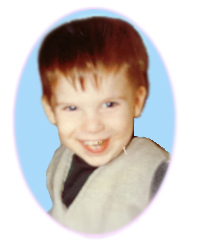
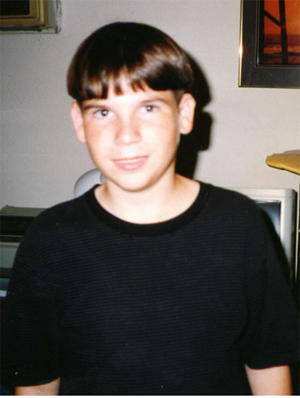 As
Jesse entered his teenage years he resisted taking his medications.
He felt that he could control his disorder and only took his meds
when he didn’t feel well. His mother and I had divorced
in 1989, two years after our move to Tucson, AZ. Jesse was under
my care after obtaining custody of my four children in 1990. At
age sixteen Jesse was now taking nearly fifty pills a day to control
his illness. Having remarried in 1992, my new wife, Mickie, and
I kept a careful watch on Jesse but as he grew older we expected
him to take more care of himself. With six children between us
we had much to consider. Jesse was being seen at a state funded
metabolic clinic in Tucson twice a year to monitor his development
and, while not always compliant, he was progressing into adulthood.
As
Jesse entered his teenage years he resisted taking his medications.
He felt that he could control his disorder and only took his meds
when he didn’t feel well. His mother and I had divorced
in 1989, two years after our move to Tucson, AZ. Jesse was under
my care after obtaining custody of my four children in 1990. At
age sixteen Jesse was now taking nearly fifty pills a day to control
his illness. Having remarried in 1992, my new wife, Mickie, and
I kept a careful watch on Jesse but as he grew older we expected
him to take more care of himself. With six children between us
we had much to consider. Jesse was being seen at a state funded
metabolic clinic in Tucson twice a year to monitor his development
and, while not always compliant, he was progressing into adulthood.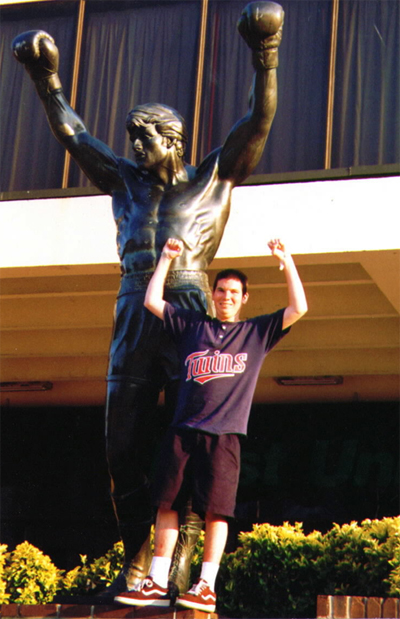 So
on Friday, June 18, 1999, Jesse with his three siblings, PJ (age
19), Mary (15), and Anne (14), and Mickie and I boarded a plane
to take us down a path we never imagined. We had a party for Jesse
that night at my brother’s house. We had a reunion with
ten of my fifteen siblings and extended families that Sunday.
It was great to see everyone. The kids got to meet cousins they
hadn’t seen in twelve years. Jesse’s cousins nicknamed
him Captain Kirk for the way he struck the volleyball with a two-handed
chop. This was turning into a great vacation.
So
on Friday, June 18, 1999, Jesse with his three siblings, PJ (age
19), Mary (15), and Anne (14), and Mickie and I boarded a plane
to take us down a path we never imagined. We had a party for Jesse
that night at my brother’s house. We had a reunion with
ten of my fifteen siblings and extended families that Sunday.
It was great to see everyone. The kids got to meet cousins they
hadn’t seen in twelve years. Jesse’s cousins nicknamed
him Captain Kirk for the way he struck the volleyball with a two-handed
chop. This was turning into a great vacation.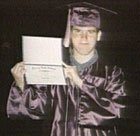 Four
weeks later, back in Tucson, we received a letter addressed to
Mr. Paul Gelsinger and Jesse. It was from another of the principal
investigators of the clinical trial, a world renowned OTC expert,
confirming Jesse’s 6% efficiency of OTC and stating that
they would like to have Jesse in their study. I presented the
letter to Jesse and asked him if he still wanted to do this. He
hesitated about a moment and said yes. This same doctor called
about a week later to follow-up his letter and spoke to Jesse
briefly. Jesse told him that he would need to call back and talk
to me and explain everything. Jesse was deferring to me to understand
this and the doctor was well aware of that. When I spoke to the
OTC expert we discussed a number of things. Since they had forgotten
to include the graph showing Jesse’s N15 results he faxed
it to us. I asked if Jesse was the least efficient patient in
the study. The doctor explained that he was and steered the conversation
to the results they had experienced to date. He explained that
they had shown that the treatment had worked temporarily in mice,
even preventing death in mice exposed to a lethal injection of
ammonia. He then explained that the most recent patient had shown
a 50% increase in her ability to excrete ammonia following gene
therapy. My reaction was to say, ”Wow! This really works.
So, with Jesse at 6% efficiency you may be able to show exactly
how well this works.” His response was that that was their
hope and that it would be for these kids. Those kids were newborn
babies with the worst form of Jesse’s disorder, having no
OTC efficiency, and with little chance of survival. He explained
that there were another 25 liver disorders that could be treated
with the same technique and that overall these disorders affected
about one in every 500 people. I did some quick math and figured
that’s 500,000 people in the U.S.A. alone, 12,000,000 worldwide.
I dropped my guard. This doctor and I never discussed the dangerous
side of this work. When I presented to Jesse what the OTC specialist
had to say he knew the right thing to do… he signed on to
help everybody and, hopefully, himself in the long run. The plan
was for him to be the last patient tested and was tentatively
scheduled for mid October.
Four
weeks later, back in Tucson, we received a letter addressed to
Mr. Paul Gelsinger and Jesse. It was from another of the principal
investigators of the clinical trial, a world renowned OTC expert,
confirming Jesse’s 6% efficiency of OTC and stating that
they would like to have Jesse in their study. I presented the
letter to Jesse and asked him if he still wanted to do this. He
hesitated about a moment and said yes. This same doctor called
about a week later to follow-up his letter and spoke to Jesse
briefly. Jesse told him that he would need to call back and talk
to me and explain everything. Jesse was deferring to me to understand
this and the doctor was well aware of that. When I spoke to the
OTC expert we discussed a number of things. Since they had forgotten
to include the graph showing Jesse’s N15 results he faxed
it to us. I asked if Jesse was the least efficient patient in
the study. The doctor explained that he was and steered the conversation
to the results they had experienced to date. He explained that
they had shown that the treatment had worked temporarily in mice,
even preventing death in mice exposed to a lethal injection of
ammonia. He then explained that the most recent patient had shown
a 50% increase in her ability to excrete ammonia following gene
therapy. My reaction was to say, ”Wow! This really works.
So, with Jesse at 6% efficiency you may be able to show exactly
how well this works.” His response was that that was their
hope and that it would be for these kids. Those kids were newborn
babies with the worst form of Jesse’s disorder, having no
OTC efficiency, and with little chance of survival. He explained
that there were another 25 liver disorders that could be treated
with the same technique and that overall these disorders affected
about one in every 500 people. I did some quick math and figured
that’s 500,000 people in the U.S.A. alone, 12,000,000 worldwide.
I dropped my guard. This doctor and I never discussed the dangerous
side of this work. When I presented to Jesse what the OTC specialist
had to say he knew the right thing to do… he signed on to
help everybody and, hopefully, himself in the long run. The plan
was for him to be the last patient tested and was tentatively
scheduled for mid October.